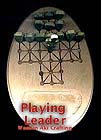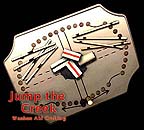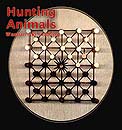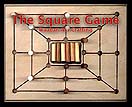| GAMES & TOYS
| ID#
| ITEM DESCRIPTION
(Click on thumbnails to view a larger image)
| PRICE
|
*NEW* Peg Games in a Native American Tradition
all games come with Native American History and Playing Instructions
|
 |
Ga1
| "Playing Leader"
A traditional Plains Cree game long known in Saskatchewan was called musinaykahwhan metowaywin, or "Playing Leader", The playing pieces were small green painted pegs carved in the shape of men, one larger than the rest, which were inserted into holes in a square board with an etched cross diagram. This two person game pits the Leader, or "oke-mow" against the other player’s thirteen Little Pegs. Players move the pegs following the lines of the board. The Little Pegs progress steadily forward to surround the Leader, while the Leader endeavors to escape and capture any unprotected Little Pegs.
| Not Available at this time.
|
 |
Ga2
| "Jump the Creek"
Kiowa Indians in Oklahoma traditionally played a stick game of "Ahl", literally meaning ‘wood’, with four willow stick dice. The original version of this game, recorded by Stuart Culin, was played on a large cotton cloth over a yard square. In the center of the cloth was a flat boulder, called the "Ahl" stone. Traditionally considered a woman’s game, using their pointed awls to mark their positions, this version substitutes a wooden board with pegs for the players. The game has two players; one "kneels" along the west half of the north-south creek, and the other is stationed along the east half of the north-south creek.
| Not Available at this time.
|
 |
Ga3
| "Hunting Animals"
Renditions of this game have been played for hundreds of years by Native Tribes of the Southwest. The size and materials used to make the board and playing pieces varies but the rules are unmistakably similar. Two players have an equal number of pieces, wooden pegs, corn, pieces of corncob, charcoal, or black and white stones which are placed on opposite sides of the board on all the intersections of the lines except the central point. The players move or jump in any direction, abandoning unused rows of the board continuously confining the area to move about in.
| Not Available at this time.
|
 |
Ga4
| "Serpent and Stones"
Long ago, an extended etched stone board was found on a house top in Zuni, and was described to be a traditional two player game of the name kolowis awithlaknannai. The kolowisi is a legendary sea serpent. As water is a precious resource in this area, the feathered serpent is a highly revered figure and his representation often appears in the Native pottery decoration of the Southwest. The game is played using black and white pieces called the awithlaknakwe, or stone warriors. These two sets of stones were sometimes pebbles and sticks, or plain and perforated pottery disks. The set of diamonds and triangles on the board resembles the pattern on the back in some portrayals of the Zuni serpent.
| Not Available at this time.
|
 |
Ga5
| The Square Game
A three-in-a-row game adopted by Natives of New Mexico, California and Arizona from the Spanish several hundred years ago. A Mono game using wooden pegs is called yakamaido, ‘square game’, or Indian checkers. In the Pueblos of New Mexico this game was called pitarilla or picaria, (similar to Spanish for ‘little stones’), and used a stone board with etched lines and playing pieces of pebbles or grains of corn. The object of the game is to remove the opponents pieces or immobilize them so they can not move.
| Not Available at this time.
|


